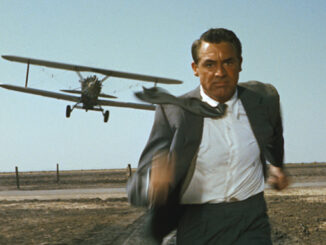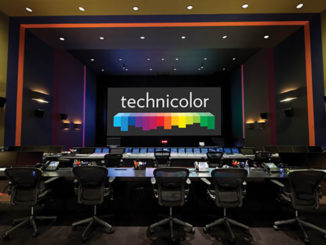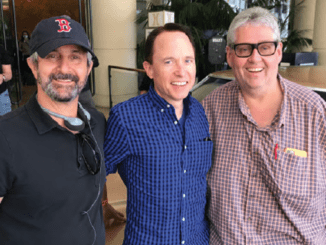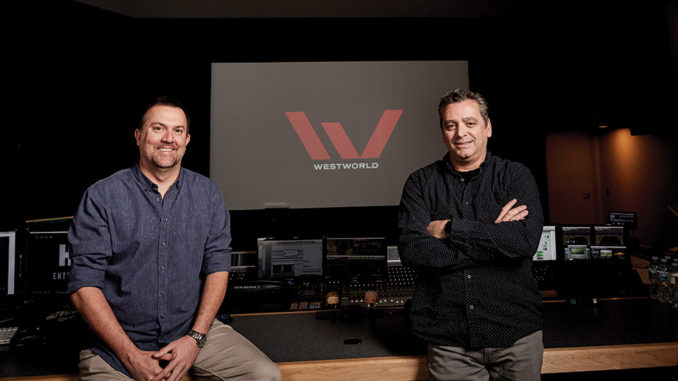
by Mel Lambert • portraits by Christopher Fragapane
With a promise of offering a novel direction for HBO’s multiple-Emmy Award-winning sci-fi drama Westworld, its second season, which premiered April 22, is also breaking new ground in the sound department. Following a trend initiated by Netflix and other content creators, HBO specified that the soundtrack for the new season’s 10 episodes should be re-recorded in native Dolby Atmos immersive format.
According to dialogue/music re-recording mixer Keith Rogers, CAS, who also worked on the series’ initial season, “Our on-air 5.1-channel deliverables are being derived from a downmix output produced by the Dolby RMU [Rendering and Mastering Unit]. After we mixed the first season’s episodes in 5.1-channel back in 2016, the showrunners and executive producers — including writer/director Jonathan Nolan and his wife/executive producer Lisa Joy — asked that we peel apart and remix the soundtrack to the immersive Atmos format” for both Blu-ray disc release and Internet streaming.
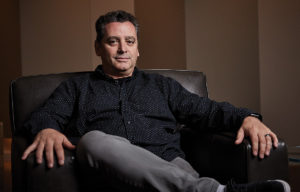
“The results worked well enough, but there were compromises in the left-right balance and placing certain elements within the immersive soundfield,” Rogers reveals. “It exposed aspects of the mix that we didn’t want the audience to hear! For that reason, the showrunners asked that for Season Two we prepare the master mix natively in Atmos format, and then use the RMU to downmix Atmos to the air-deliverable 5.1-channel format. We also recorded a number of 7.1.2 stems and objects, together with 5.1-channel stems from the RMU. The show’s M&E [music and effects] elements are prepared in another department using our master native Atmos Pro Tools sessions.”
Loosely based on director Michael Crichton’s 1972 film of the same name, Westworld depicts a futuristic world in which an exclusive theme park allows “guests” to indulge their most primal fantasies with their robotic “hosts” without consequences. But these illicit, artificial intelligence-based fantasies do have outcomes for the guests. The series stars Evan Rachel Wood, Thandie Newton, Jeffrey Wright, James Marsden, Ed Harris and Anthony Hopkins.
For the new season, Rogers worked with sound effects mixer Andy King, CAS, at Universal Studios’ Mix 2 re-recording stage (Rogers was paired with Scott Weber for Season One), and the pair possesses prior experience mixing in native Atmos, having prepared the soundtrack for Netflix’s sci-fi series, Altered Carbon (2018), which wrapped late last year and aired in February. “During our early meetings with the Westworld showrunners, we spoke about the sound signature for Season Two and any new directions the soundtrack might take,” says Rogers. “Jonathan Nolan loves Atmos motion picture sound and the way music sounds bigger and more immersive” in that format.

“For Season Two, Jonathan and Lisa wanted to experiment with new textures and techniques to tell the story,” Rogers continues, “including conceptual and more dreamy effects for the dialogue to move inside the characters’ heads, and signal flashbacks or flash-forwards. They wanted sound to blur the line between reality and fantasy for hosts and guests, and also wanted a stronger emphasis on the musical score.”
Westworld’s first season picked up a Primetime Emmy Award last year for Outstanding Sound Mixing for a Comedy or Drama Series (One Hour), in addition to 22 Emmy nominations, including Outstanding Sound Editing for a Series, together with MPSE Golden Reel Awards for Best Sound Editing – Short Form Sound Effects and Foley in Television, as well as Best Sound Editing – Long Form Sound Effects and Foley in Television. The sound editorial team for both seasons has been headed by supervising sound editor Thomas deGorter, MPSE, working with dialogue editor Fred Paragano, CAS, ADR supervisor Brett Hinton, sound effects editors Mark Allen, MPSE, and Marc Glassman, MPSE, and music editor Christopher Kaller.
“If the first season was defined by control, the second season is defined by chaos,” Nolan explained in a recent statement. “That’s part of what we come to understand that Ford [the park’s founder, played by Hopkins] has been planning all along. Is his plan to let Dolores [Wood] or the other hosts escape? Are they simply to teach the human guests a lesson?”
Key Sound Elements
For dialogue tracks, Rogers looks for the best possible choice of mic from production. “I normally opt for the boom microphone because it offers a richness and better overall quality, although I’ll turn to alternate mics if there are location issues,” he explains. “We have a few ADR tracks — normally for performance issues — but the show loops very few lines, apart from foreign language and lines added after the shoot. And the music [from series composer Ramin Djawadi] is wall-to-wall; we often have 59 minutes of score for each hour-long episode, including live strings, synthesized strings and other elements.
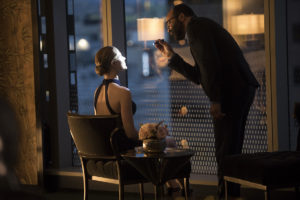
“The feel of the show comes from the music, which is very important for Jonathan Nolan in the creation of sonic landscapes since it drives the action and gives focus during the flashbacks,” Rogers continues. “We also have source music in the club scenes and a player piano for the Western saloon, for which there might be an ’80s or ’90s rock song from Radiohead, Nirvana or the Rolling Stones, re-done in that characteristic player-piano style.”
While dialogue, ADR and group elements arrive on the stage as mono or stereo tracks, music is delivered as multiple quad tracks divided into percussion, string, synth and other categories, “with stereo sweeteners that often serve as sound effects during scene transitions,” Rogers adds. “I like to keep dialogue in the center channel, panning left-right as necessary, and can add height using ambience and reverb, although I normally reserve the height speakers for PA announcements and the like. I’ll use an iZotope RX plug-in to clean up dialogue and the Cargo Cult Slapper multi-tap surround delay — together with Avid’s Reverb One and Audio Ease Altiverb 7— for reverb/ambiences. Currently, we are running 176 tracks of music and over 100 combined DX/ADR/Group tracks per episode.”
Each episode of Westworld normally requires six days for the native Atmos mix, with the first day being spent exploring the elements and pre-dubbing into familiar DME groups. “We are very organized,” Rogers stresses. “While I’m working on pre-dubbing key dialogue and music tracks, Andy will be pre-dubbing his 350-plus sound effects tracks using headphones.”
“I like to use Jerry Harvey [JH Audio] in-ear headphones, which deliver the pre-dubbing volume I need,” King confirms. “They’re the same IEMs that musicians use on stage, and are a game changer for me due to their sound isolation and frequency response.” The team has three days to shape the show and develop a mix they can play for the showrunners. On Universal’s Mix 2, the re-recording mixers use an Avid ICON D-Control console surface with 48 on-surface faders linked to Pro Tools HD 12.8.3 with Atmos integrated panners.
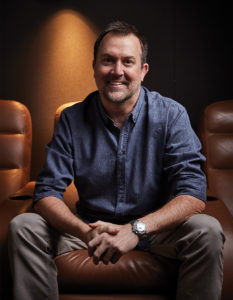
King worked with sound effects editor Mark Allen, MPSE, “to create a Pro Tools template that worked for both of us — one that dovetails perfectly with my mix template,” he explains. “I have eight buckets of eight mono or eight stereo channels for hard effects; a bucket of Atmos Objects — eight mono/eight stereo; five buckets of six mono/two stereo horse elements, including Vox, Bridle, Hoof, Extra A and Extra B; a bucket of OMF tracks; a bucket of production effects tracks; a BG A bucket with 30 tracks of mono/stereo combos; a BG B bucket with 30 tracks of mono/stereo combos; and a BG E bucket for English language or otherwise, with splits for easier M&E creation.”
The effects mixer also has up to 25 tracks of Foley footsteps, “maybe 15 tracks of Foley props plus Foley pats, sits, etc., and a channel of Foley cloth,” he says. “Then there’s a bucket of reverb returns; one of master outs that feed my iZotope Insight plug-ins — they don’t make a 10-channel version, so I jury-rigged a 5.1 and a Quad — and a separate iZotope RX Monitor for RX6.
throughput. Using the RX6 plug-in, I can dive in and use noise reduction on backgrounds and some effects, especially when I have to push them above loud, wide frequency-range music and the noise gets audible. I also use it to clean up and reduce frequency bands to make things find their space. And I must pay tribute to our amazing stage recordist Rick Camara and engineer Mike Morongell.”
At the end of the first day of the mix, Rogers will add the effects pre-dubs and “adjust ambiences against the music, which is very prominent,” he explains. “I like mixing music in Atmos; I find that the sweet spot is higher and off the screen. I prefer to have the music as a broad left-right spread across the Atmos soundfield and into the sides, with secondary music cues as objects placed high up and separate from the music bed. I am constantly checking the Atmos/5.1-channel compatibility to make sure that the latter is not surround-heavy.” King adds, “We get a lot done in a short period of time; we also handle trailers and promos!”
For the new season of Westworld, the mixers pushed the dialogue and added new soundscapes. “With native Amos, we have new textures that the show didn’t have last season,” Rogers explains. “We have been getting more aggressive with the sound without it being too obvious. The show is story-driven and very dynamic, yet subtle in areas with new textures for the soundtrack.”
Currently, the mixing team does not use a nearfield monitor path, mixing instead on the stage’s large loudspeaker system. “Our confidence in Dolby’s downmix algorithm is high,” King maintains. “However, we have configured a nearfield stereo Genelec 8050 setup for those occasions where the 2.0 reference is critical — usually due to issues that arise upon review in the picture-cutting rooms. It’s common to run into audio systems that aren’t always tuned or calibrated to spec, thereby creating translation problems when producers and picture editors review our mixes back at the office. And, on occasion, we make QuickTime videos of our mixes to check playback on computers or smartphones, since there is an entire generation of folks who listen to our hard work exclusively on those types of devices.”
Atmos Mix and 5.1-channel Deliverables
According to Rogers, the Dolby RMU can deliver two modes of downmix: standard and direct. “We opted to use 5.1-channel direct mode because it preserves the Atmos imaging by moving the mix towards the front soundscape and away from the surrounds,” he says. “We felt that such a mix better serves the home audience that is listening in 5.1-channel surround” or a stereo downmix from set-top boxes and AV receivers.
“The direct mode keeps the sound energy forward to the screen channels and is more true to the original Atmos mix,” elaborates King, who adds, “We deliver a very theatrical mix. I keep one pre-dub bucket open for Atmos SFX objects that are scene- or case-specific. My choice of what goes in the bed or is treated as an object depends upon our entertainment criteria. They can be helicopter flybys or more subtle — flies on dead animals, for example — or used for ambiences that include birds and critters. I pan sounds like gunshots and explosions to match their on-screen positions.”
Instead of using the ICON’s joysticks to control Pro Tools’ Atmos software panners, King says he prefers to use a mouse for panning. “And while checking Atmos/5.1 compatibility, I listen for sounds that are key to a scene,” he says. “For example, we placed rope creaks into the overhead channels [during a hanging scene]. In 5.1-channel, I need to determine where they end up and that they are not distracting the audience’s attention.”
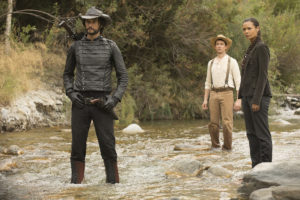
King recalls that Westworld’s showrunners were looking for “an open, ‘wild west’ sound in key scenes, with a very live feel — gunshots in the surrounds, for example. “I used ambience to pull effects off the screen with left and right panning,” he adds. “I also spun the entire soundfield by 180 degrees vertically into the height channels during the hanging scene. Atmos is a great mix configuration because you have control over wide open space to create a detailed immersive environment, which the producers enjoy. They have been very receptive to our ideas. To let us develop a consistent sound, we re-recorded the first four episodes of Season Two prior to our playback sessions. The showrunners loved what we had done with just a few notes.”
In terms of Atmos deliverables, Rogers prepares a 7.1.2 DX Stem, a 7.1.2 DX ALT Stem (foreign language), a 7.1.2 Group Stem, a 7.1.2 MX Stem, 10 DX Objects, 10 MX Objects and 10 Group Objects. “My Atmos FX stem deliverables consist of a 7.1.2 (10-channel) FX Stem, 7.1.2 (10-channel) BG Stem, a 5.0 Foley Stem and a 5.0 Alternate BG Stem — which typically is for isolating discernable English dialogue for M&E creation,” relates King. “Downstream deliverables are derived from these via re-render outputs from the Dolby RMU, and are captured simultaneously by a second record machine. It’s my understanding that, currently, HBO only requires 5.1 DME and print master material, with Atmos as an archive, but that may be subject to change going forward. We are all working ahead of the curve!”
The Atmos 7.1.2-channel stem and print master format was selected because of infrastructure and storage restrictions. “That physical limitation meant that we standardized on a 10-channel Atmos mastering format,” explains King, who used a 7.1.2 bed and discrete objects. “For the 5.1-channel air deliverables, we shoot for a standard -24 LKFS loudness level from the RMU downmix,” Rogers adds. “We are still working on a standard loudness level for the Atmos immersive mix.”
The re-recording mixers readily acknowledge that they work well together in a highly collaborative environment. “We share the same sensibilities about when a mix is working for us,” King offers. “I didn’t need to get acclimated to Keith’s workflow since he is very open and creative in his mix style. It continues to be a great partnership. After all, we are mixing an hour-long TV movie in just six days; we have to be on the same page. With Season Two, we’re not in Kansas anymore!”
“As a mix team, we need to be in sync with one another,” Rogers concludes. “In addition to Westworld and Altered Carbon, Andy and I have worked on both Halt and Catch Fire [2014-2017] and Mr. Mercedes [2017-present]. We are an extension of what the client wants to achieve. Andy’s nickname on the dub stage is ‘Pandy’ because he loves to pan sounds and create space; he is a very efficient mixer.”



